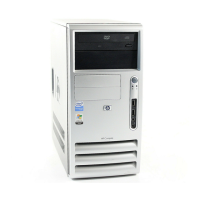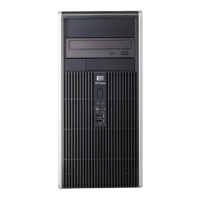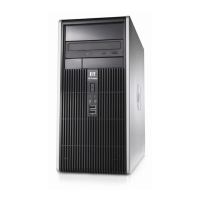5–2 336493-004 Service Reference Guide, d200
Identifying the Chassis, Routine Care, and Disassembly Preparation
5.2 Electrostatic Discharge Information
A sudden discharge of static electricity from your finger or other conductor can destroy
static-sensitive devices or microcircuitry. Often the spark is neither felt nor heard, but damage
occurs. An electronic device exposed to electrostatic discharge (ESD) may not appear to be
affected at all and can work perfectly throughout a normal cycle. The device may function
normally for a while, but it has been degraded in the internal layers, reducing its life expectancy.
Networks built into many integrated circuits provide some protection, but in many cases, the
discharge contains enough power to alter device parameters or melt silicon junctions.
5.2.1 Generating Static
The following table shows that:
■ Different activities generate different amounts of static electricity.
■ Static electricity increases as humidity decreases.
✎
700 volts can degrade a product.
Microtower Type 2 Chassis Variations
Chassis Characteristic d220, d228, d230 d240, d248
Power supply mounting
method
Removable power supply
support bracket
No support bracket required
Power supply installation
method
Lay chassis on its side for
easiest installation
Keep chassis in upright
position for easiest installation
Lower drive cage retaining
screws
Four screws on front of chassis
plus one on the side
Three screws on front of
chassis plus one on the side
Processor cooling method Air baffle Chassis fan
Memory Single channel Dual channel
Number of memory sockets 2 4
Relative Humidity
Event 55% 40% 10%
Walking across carpet
Walking across vinyl floor
Motions of bench worker
7,500 V
3,000 V
400 V
15,000 V
5,000 V
800 V
35,000 V
12,000 V
6,000 V
Removing bubble pack from PCB
Packing PCBs in foam-lined box
7,000 V
5,000 V
20,000 V
11,000 V
26,500 V
21,000 V
